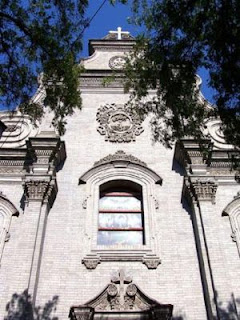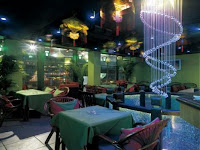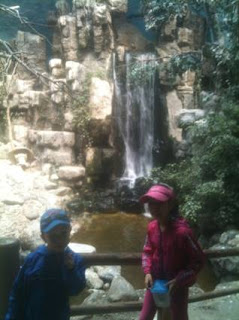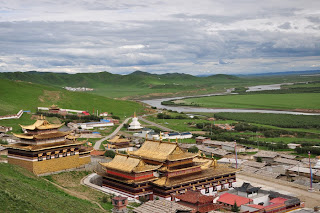2013年8月29日星期四
Tomb of General Yue Fei In Hangzhou City
Yue Fei (1103 - 1141) came from Tangyin in Xiangzhou of today's Henan Province. He was a great general famous for wars against the Jin Dynasty (1115 - 1234) in the Song Dynasty (960 - 1279). After he joined the army, he and his troops continuously won wars against the Jin. However, after Yue and his army had recovered most of the lost territory, Emperor Gaozong (1107 - 1187) embraced the evil plot of Qin Kuai (1090 - 1155, Prime Minister of the Song Dynasty) and surrendered to the Jin. As a result, he was falsely accused and later secretly killed in jail. A few years later, the wrong was put right when Emperor Xiao Zong (1163 - 1189) came to power. The tomb was built in memory of this great hero. Yue Fei is always considered as a national hero.
The Tomb of General Yue Fei has been demolished and renovated several times. The existing one was rebuilt in 1715 in the Qing Dynasty (1644 - 1911) and comprehensively repaired in 1979.
Occupying an area of four acres, the tomb is located at the southern foot of Qixia Hill near the West Lake. Entering the gate with double eaves, a patio with towering trees on both sides is found. The Shrine of Remembrance, the main hall, is right in the center. A sculpture of general Yue is set in the middle of the hall. He is in a colorful embroidered round cushion cover. Looking solemn and mighty, he has a sword in his hand and looks as if he is ready to protect his country. Over the sculpture is tablet in the original handwriting of Yue Fei, which states returning our territory and keeping it integrated. At the back of the hall are large pictures depicting his life stories. On the floor of the hall is a picture depicting 373 cranes. These cranes are the symbols of his integrity and faithful mind.
General 's Grave
Metal sculptures of sinners who killed Yue Fei
To the west of the main hall is a yard. There are two corridors exhibiting poems written to commend Yue. Striding over the bridge in the middle of the yard, there are the tombs of Yue Fei and his son's. Yue Fei's tomb is right in the center, and to its left is the tomb of his son Yue Yun who had been a competent assistant of his father on the battlefields. Stone horses, tigers, and sheep of the Ming Dynasty (1386 - 1644) decorate both sides of the enclosure. This tomb, which had been destroyed several times, was rebuilt and possesses the features of the Song Dynasty. Facing the tomb are four iron sculptures, including Qin Kuai the chief plotter, in kneeling position. Concerning these sculptures, people wanted them to atone for their crime forever.
2013年8月25日星期日
Capatial City of China Beijingers are Hospitable
China is well known for its rites and etiquettes, and has had the ancient lesson,"It is such a delight to have friends coming from afar". Beijingers have inherited this excellent tradition and made the warm invitation of "welcome to Beijing" to friends from all over the world.
Beijingers value etiquettes and feelings and always lend a warm hand to foreign friends in need and care for you and help you as if you were their family member. Especially, after 2008 Beijing Olympic Games, the spirit of Olympic volunteers has taken root here and is spread to become a common practice.
The king demeanor of five dynasties and the capital style of the country have been integrated into the bloods of Beijingers, have cut and polished the personalities of Beijingers and cultivated the generous attitudes of conducting themselves and ease style of behavior as well as warm, friendly and merciful positive attitude to foreign things.
2013年8月21日星期三
Beijing Zoo – A Family Favorite
As a lover of both animals and boats, I've often imagined myself traveling 3,000 or so years back in history to Noah's Ark, where I could spend my days feeding and watching all sorts of animals aboard that enormous floating zoo. Now, I live in Beijing which is no boater's paradise, but it has an awesome zoo where, if I don't mind paying a little extra, I can even feed some of the animals.
After my family returned home from this week's zoo visit, I decided to surf around and see what people on the net were saying about the Beijing zoo. There were positive comments about some animals and the park-like environment, but I was surprised to see so much criticism. Let me reiterate, I'm an avid lover of animals and I loathe any kind of abuse. I cringe when I see live chickens in the market stuffed into tiny cages. But what I see in the Beijing Zoo is anything but abusive.
Frankly, the animals in the zoo are better fed than many people in the world. My kids were amazed to see plates of fresh cut fruit and vegetables being carried to the monkeys and birds. Pelicans wade through more fresh fish than they could ever eat in a day. The extra fee to enter the “kids' zoo” area includes a handful of fresh greens to feed the geese and peacocks (pictured at left). Ponies weren't even interested in the wad of lettuce in my daughter's hand because their feeder was already filled with hay. I don't know which gives me the most delight; seeing the smile on my kids' faces when they feed their little friends, or watching the animals enjoy the feast.
Some of the more favorable online comments applauded the zoo for its environment as a beautiful park. I agree. We used to live within walking distance of the zoo. In those days we always bought annual passes. Taking our kids there just like taking them to any park in town. Although kids never tire of watching animals, we made some of our most precious memories just relaxing and playing in the remote wooded areas of the zoo. With our pass, the zoo was no longer a novelty, but more of a back yard to enjoy as often as we liked. We no longer live in the neighborhood of the zoo, so we don't have the annual pass, but the entrance fee is about the same as some public parks, so even if we weren't animal lovers it would be worth the visit.
The zoo also makes a great photo studio. There are lots of great backgrounds for family, couple or individual photos, like the picture on the right of my kids in front of a waterfall.
2013年8月16日星期五
Magnificent First Bend of the Yellow River
The Yellow River, called the Mother River of China, originates from the Bayankala Mountains in Qinghai
Province and flows from the west to the east. Its twists and turns have formed the magnificent First Bend of the Yellow River at Tangke Township, Ruoergai County, Aba prefecture of Sichuan Province. It is the land where the Yellow River crosses, where the Chinese Red Army once passed through, and where the ancient Tibetan King Gesar fought a battle…
Province and flows from the west to the east. Its twists and turns have formed the magnificent First Bend of the Yellow River at Tangke Township, Ruoergai County, Aba prefecture of Sichuan Province. It is the land where the Yellow River crosses, where the Chinese Red Army once passed through, and where the ancient Tibetan King Gesar fought a battle…
2013年8月11日星期日
Xuanwumen Church
 Southern Church is the oldest Catholic Church in Beijing, the Southern Cathedral, also known as the Cathedral of the Immaculate Conception, is located at 181 Qianmen West Street in the Xuanwumen area. The church was first erected in the middle of the 16th century on the former site of the Donglin party, a political clique active in the late Ming Dynasty (1368-1644).
Southern Church is the oldest Catholic Church in Beijing, the Southern Cathedral, also known as the Cathedral of the Immaculate Conception, is located at 181 Qianmen West Street in the Xuanwumen area. The church was first erected in the middle of the 16th century on the former site of the Donglin party, a political clique active in the late Ming Dynasty (1368-1644).When the Italian missionary Matteo Ricci came to China during the reign of Emperor Wanli in Ming Dynasty, the emperor provided him with a residence which stood slightly west of the cathedral. The cathedral was rebuilt in 1657 during the reign of Emperor Shunzhi of the Qing Dynasty. The cathedral was severely damaged by earthquakes in 1775 and 1900, and was rebuilt in 1904 to its present form. The main components of the 100-year-old building remain unchanged with one exception-its wooden support columns have been replaced by brick-and-mortar columns decorated with stone mosaics.
Today the cathedral remains in excellent condition. Masses conducted by more than 10 Chinese Fathers attract an increasing number of Chinese and foreign worshipers every Sunday, and the church is always crowded during Easter and Christmas.
2013年8月8日星期四
The Wudaokou Hotspots City Brief of Beijing
 The Wudaokou hotspots aren't flashy or fashionable. They are, with few exceptions, cheap and welcoming, playing host to hipsties, pop-and-lockers and
The Wudaokou hotspots aren't flashy or fashionable. They are, with few exceptions, cheap and welcoming, playing host to hipsties, pop-and-lockers and hip-hoppers, rochers and ballers, and the jocks and the nerds all at once. Over the past few years, the student crowd and their drinking holes have developed a unique style and neighborhood snobbery. Old cornerstones near the light-rail station like Lush-with its weekly Sunday open-mic night and sinfully scrumptions hangover breakfast-and propaganda-with its grinding meat market-still flourish.
2013年8月5日星期一
Beihai Park AAAA Tourist Attraction
Beihai Park is an AAAA tourist attraction and a key historic site under national protection. Its east and south sides are close to the Palace Museum. It can be reached by many bus routes.
The park used to be an imperial palace serving for the emperors of five dynasties (Liao, Jin, Yuan, Ming, and Qing) and their families to stay for a short time, handle political affairs, or offer sacrifices. At the age of 800, it is the earliest built and best preserved imperial garden in the world.
The park, which creatively follows traditional Chinese architectural tenets and techniques, is a classical Chinese garden and a valuable cultural heritage. It covers 682,000 square meters, with a 389,000-square-meter water-covered area. Its layout-one lake dotted with three isles-embodies a Chinese mythology about the fairyland, and achieves an artistic blending of natural and cultural landscape. Two of the Eight Attractions of Yanjing (Beijing) are located here-Spring Shade on Qionghua Island and Autumn Breeze over Taiyechi.
The park has three major attractions-Qionghua Island, Tuancheng Island, and the north bank. The white pagoda on Qionghua Island has become synonymous with Beihai Park. In the shades of the willows framing the lake are many well-known scenic spots, such as Haopujian, Jingxinzhai, Hall of Heavenly Kings, Kuaixue Hall, Nine-dragon Screen, Five-dragon Pavilion, Chanfu Temple, and Xiaoxitian.
The park offers a variety of boating entertainment and holds exhibitions all the year round. It's a wonderful stop for tourists.
The park used to be an imperial palace serving for the emperors of five dynasties (Liao, Jin, Yuan, Ming, and Qing) and their families to stay for a short time, handle political affairs, or offer sacrifices. At the age of 800, it is the earliest built and best preserved imperial garden in the world.
The park, which creatively follows traditional Chinese architectural tenets and techniques, is a classical Chinese garden and a valuable cultural heritage. It covers 682,000 square meters, with a 389,000-square-meter water-covered area. Its layout-one lake dotted with three isles-embodies a Chinese mythology about the fairyland, and achieves an artistic blending of natural and cultural landscape. Two of the Eight Attractions of Yanjing (Beijing) are located here-Spring Shade on Qionghua Island and Autumn Breeze over Taiyechi.
The park has three major attractions-Qionghua Island, Tuancheng Island, and the north bank. The white pagoda on Qionghua Island has become synonymous with Beihai Park. In the shades of the willows framing the lake are many well-known scenic spots, such as Haopujian, Jingxinzhai, Hall of Heavenly Kings, Kuaixue Hall, Nine-dragon Screen, Five-dragon Pavilion, Chanfu Temple, and Xiaoxitian.
The park offers a variety of boating entertainment and holds exhibitions all the year round. It's a wonderful stop for tourists.
订阅:
博文 (Atom)



